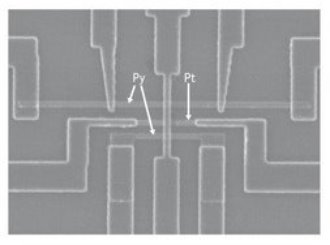Mar. 28, 2008 Research Highlight Physics / Astronomy
Scatter and spin
The spin Hall effect in platinum is mainly caused by scattering within the wire
 Figure 1: Scanning electron microscope image of the modified lateral spin valve for measuring the spin Hall effect in platinum. Permalloy (Py) and platinum (Pt) wires are indicated, all other components are copper. © Physical Review Letters/The American Physical Society/99/226604-2 (2007)
Figure 1: Scanning electron microscope image of the modified lateral spin valve for measuring the spin Hall effect in platinum. Permalloy (Py) and platinum (Pt) wires are indicated, all other components are copper. © Physical Review Letters/The American Physical Society/99/226604-2 (2007)
When a wire carrying electric current is placed in a magnetic field, the flowing electrons are deflected by a force at right angles to the field. This phenomenon, called the Hall effect, has found applications in many types of electronic sensors.
Now scientists hope to build ‘spintronic’ devices using a similar phenomenon called the spin Hall effect, which results from a particle’s intrinsic angular momentum, or spin, rather than its electric charge. YoshiChika Otani and Takashi Kimura at the University of Tokyo and the RIKEN Frontier Research System in Wako have explained why the spin Hall effect is particularly strong in platinum1.
Any moving charged particle generates a magnetic field because of its spin. In the spin Hall effect, these spin magnetic moments are deflected by a right-angled force when they are placed in an electric field—the opposite case to the classical Hall effect. If the spins are all pointing in the same direction—a so-called ‘spin-polarized’ current—the spins accumulate at one edge of the wire. This opens up the possibility of generating and detecting spin currents without needing magnetic fields.
Many researchers have looked at the spin Hall effect in semiconductors, because they are easily compatible with current technology. But the effect is small in semiconductors, especially compared to platinum, which has the largest spin Hall effect so far measured2.
“For platinum, there is a lot of discussion concerning the origin of the spin Hall effect,” says Otani. “One [idea concerns an] intrinsic origin due to the electric band structure, another is an extrinsic origin due to defects or impurities.”
Otani and colleagues modified a tiny spintronic device called a lateral spin valve3,4 to measure the spin Hall conductivity in platinum wires of varying thicknesses and at different temperatures (Fig. 1). They found that the spin Hall effect decreased for thicker wires because the spins could relax back to more random orientations, losing their polarization. The results also showed that the spin Hall effect is mainly caused by scattering within the metal.
This new knowledge could allow greater control over the spin Hall effect. Unfortunately, the effect is largest at very low temperatures that are not practical for everyday devices—a problem the researchers hope to overcome in future. “At the moment, the observed spin Hall effect [at room temperature] is too small,” says Kimura. “The challenge will be how to enlarge the effect.”
References
- 1. Vila, L., Kimura, T. & Otani, Y. Evolution of the spin Hall effect in Pt nanowires: size and temperature effects. Physical Review Letters 99, 226604 (2007). doi: 10.1103/PhysRevLett.99.226604
- 2. Kimura, T., Otani, Y., Sato, T., Takahashi, S. & Maekawa, S. Room-temperature reversible spin Hall effect. Physical Review Letters 98, 156601 (2007). doi: 10.1103/PhysRevLett.98.156601
- 3. Kimura, T., Otani, Y. & Levy, P.M. Electrical control of the direction of spin accumulation. Physical Review Letters 99, 166601 (2007). doi: 10.1103/PhysRevLett.99.166601
- 4. Kimura, T. & Otani, Y. Large spin accumulation in a permalloy-silver lateral spin valve. Physical Review Letters 99, 196604 (2007). doi: 10.1103/PhysRevLett.99.196604
